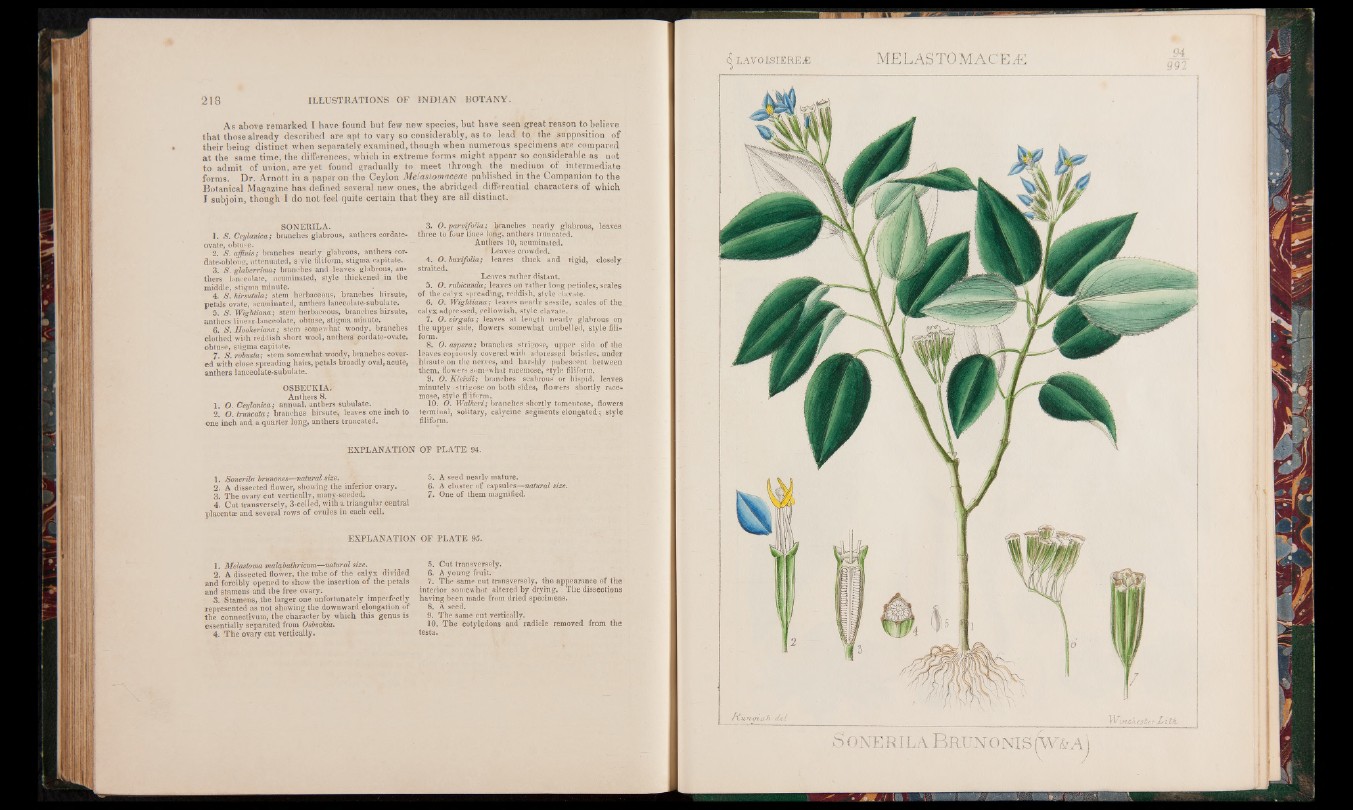
As above remarked I have found but few new species, but have seen great reason to believe
that those already described are apt to vary so considerably, as to lead to the supposition of
their being distinct when separately examined, though when numerous specimens are compared
at the same time, the differences, which in extreme forms might appear so considerable as not
to admit of union, are yet found gradually to meet through the medium of intermediate
forms. Dr. Arnott in a paper on the Ceylon Melastomnceae published in the Companion to the
Botanical Magazine has defined several new ones, the abridged differential characters of which
I subjoin, though I do not feel quite certain that they are all distinct.
SONERILA.
1. S. Ceylanica; branches glabrous, anthers cordate-
ovate, obtuse.
2. S.affinis; branches nearly glabrous, anthers cordate
oblong, attenuated, s' vle filiform, stigma capitate.
3. S. glaberrima; branches and leaves glabrous, anthers
lanceolate, acuminated, style thickened in the
middle, stigma minute.
4. S. hirsutula; stem herbaceous, branches hirsute,
petals ovate, acuminated, anthers lanceolate-subulate.
5. S. Wightiana; stem herbaceous, branches hirsute,
anthers linear-lanceolate, obtuse, stigma minute.
6. S . Hookeriana; stem somewhat woody, branches
clothed with reddish short wool, anthers:’ .cordate-ovate,
obtuse, stigma capitate.
7 . S . robusta; stem somewhat woody, branches covered
with close spreading hairs, petals broadly oval, acute,
anthers lanceolate-subulate.
OSBECKIA.
Anthers 8.
1. O. Ceylanica; annual, anthers subulate.
2. O. truncata; branches hirsute, leaves one inch to
one inch and a quarter long, anthers truncated.
3. O.parvifolia; branches nearly glabrous, leaves
three to four lines long, anthers truncated.
Anthers 10, acuminated.
- Leaves crowded.
4. O. buxifolia; leaves thick and rigid, closely
straited.
Leaves rather distant.
5. O. rubicunda; leaves on rather long petioles, scales
of the ca'yx spreading, reddish, style ■•lav-ite.
6. O. Wightiana; leaves nearly sessile, scales of the.
calyx adpressed, yellowish, style clavate.
7. O. virgata; leaves at length nearly glabrous on
the upper side, flowers somewhat umbelled, style filiform.
8. O. aspera; branches strigose, upper side of the
leaves copiously covered with adpiessed bristles, under
hirsute on the nerves, and harshly pubescent between
them, flowers somewhat racemose, style filiform.
9. O. Kleiidi; branches scabrous or hispid. leaves
minutely strigose on both sides, flowers shortly racemose,
style fl’iform.
10. O. Walkeri; branches shortly tomentose, flowers
terminal, solitary, calycine segments elongated; style
filiform.
EXPLANATION OF PLATE 94.
1. Sonerila brunones—natural size.
2. A dissected flower, showing the inferior ovary.
3. The ovary cut vertically, many-seeded.
4. Cut transversely, 3-celled, with a triangular central
placentae and several rows of ovules in each cell.
5. A seed nearly mature.
6. A cluster of capsules—natural size.
7. One of them magnified.
EXPLANATION OF PLATE 95.
5. Cut transversely.
6. A young fruit.
7. The same cut transversely, the appearance of the
interior somewhat altered by drying. The dissections
having been made from dried specimens.
8. A seed.
9. The same cut vertically.
10. The cotyledons and radicle removed from the
testa.
1. Melastoma malabathricum—natural size.
2. A dissected flower, the tube of the calyx divided
and forcibly opened to show the insertion of the petals
and stamens and the free ovary.
S. Stamens, vthe larger one unfortunately imperfectly
represented as not showing the downward elongation of
the connectivum, the character by which this genus is
essentially separated from Osbeckia.
4. The ovary cut vertically.
» LAVOLSIEREÆ MELAS TOMACEÆ
S o n e r il a B r u n o n i s /w a a